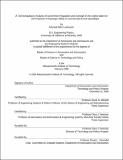| dc.contributor.advisor | David A. Mindell and Dava Newman. | en_US |
| dc.contributor.author | Leybovich, Michael Elliot | en_US |
| dc.contributor.other | Massachusetts Institute of Technology. Dept. of Aeronautics and Astronautics. | en_US |
| dc.coverage.spatial | n-us--- | en_US |
| dc.date.accessioned | 2010-08-26T15:14:31Z | |
| dc.date.available | 2010-08-26T15:14:31Z | |
| dc.date.copyright | 2009 | en_US |
| dc.date.issued | 2009 | en_US |
| dc.identifier.uri | http://hdl.handle.net/1721.1/57522 | |
| dc.description | Thesis (S.M. in Technology and Policy)--Massachusetts Institute of Technology, Engineering Systems Division, Technology and Policy Program; and, (S.M.)--Massachusetts Institute of Technology, Dept. of Aeronautics and Astronautics, 2009. | en_US |
| dc.description | This electronic version was submitted by the student author. The certified thesis is available in the Institute Archives and Special Collections. | en_US |
| dc.description | Cataloged from student submitted PDF version of thesis. Vita. | en_US |
| dc.description | Includes bibliographical references (p. 80-91). | en_US |
| dc.description.abstract | Commercial human spaceflight looks ready to take off as an industry, with "space tourism" as its first application. Paying passengers are likely to begin taking suborbital spaceflights within the next several years, both despite and because of the risks and hazards inherent in human spaceflight. As this activity poses dangers to passengers, there will be an increasing degree of government regulation and oversight to protect participant safety. Though human spaceflight is not a new endeavour, commercial human spaceflight poses a new set of challenges for regulators to grapple with. As is the case with many emerging technological industries, the regulatory challenge is to protect the safety of both participants and the uninvolved without regulating to a degree that stifles industry innovation and growth. This thesis examines the history and regulation of commercial human spaceflight to date. The technical background, systems engineering, and risk management of human spaceflight are explored, to determine which particular subsystem-mission phase combinations warrant closer regulatory attention. Finally, this paper gives recommendations on how future regulation of this nascent industry ought to be approached by the federal government and its regulatory agencies. | en_US |
| dc.description.statementofresponsibility | by Michael Elliot Leybovich. | en_US |
| dc.format.extent | 96 p. | en_US |
| dc.language.iso | eng | en_US |
| dc.publisher | Massachusetts Institute of Technology | en_US |
| dc.rights | M.I.T. theses are protected by
copyright. They may be viewed from this source for any purpose, but
reproduction or distribution in any format is prohibited without written
permission. See provided URL for inquiries about permission. | en_US |
| dc.rights.uri | http://dspace.mit.edu/handle/1721.1/7582 | en_US |
| dc.subject | Engineering Systems Division. | en_US |
| dc.subject | Technology and Policy Program. | en_US |
| dc.subject | Aeronautics and Astronautics. | en_US |
| dc.title | A technoregulatory analysis of government regulation and oversight in the United States for the protection of passenger safety in commercial human spaceflight | en_US |
| dc.type | Thesis | en_US |
| dc.description.degree | S.M. | en_US |
| dc.description.degree | S.M.in Technology and Policy | en_US |
| dc.contributor.department | Massachusetts Institute of Technology. Department of Aeronautics and Astronautics | |
| dc.contributor.department | Massachusetts Institute of Technology. Engineering Systems Division | |
| dc.contributor.department | Technology and Policy Program | |
| dc.identifier.oclc | 618475269 | en_US |
